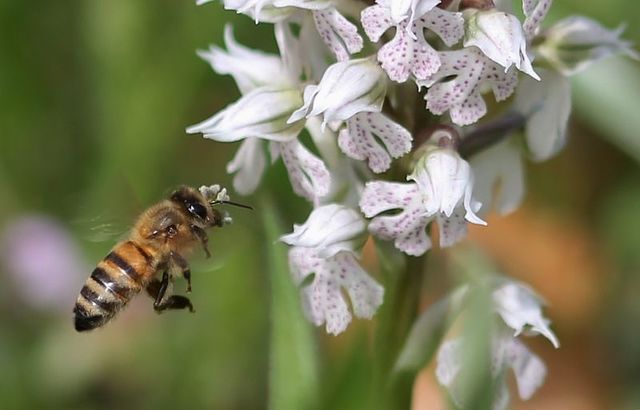After flowering the plant must get pollinated for the fruit to set and for seed formation to take place. Pollination occurs in many different ways in a plant. Some plants self-pollinate, i.e., pollen from the anther settles on the stigma of same plant. These are called cleistogamous plants. Plants which cross-pollinate, i.e., the stigma accepts pollen from plants other than its own self, these are the chasmogamous plants. Orchids being highly diverse and adaptive, do not favour cleistogamy.
For pollination to occur the plant has to work hard at attracting pollinating agents which can be insects, birds and animals. Natural pollinators of orchids include small insects such as bees, wasps, moths etc., and then there are bird pollinators too. Orchids are very specific about their pollinators. This is another reason that deforestation of orchid inhabited areas is affecting the orchid populations around the world.
Orchids have developed interesting ways to entice the pollinators to their flowers. Pollination in orchids is mostly by insects and birds, with some cases of pollination by ants though these do more harm than good! Orchids pollinated by insects have developed certain features (though you can never rule out exceptions) like having a small size, many bribe their insect visitors with nectar, some orchids trick male insects by mimicking the female body parts or its scent. These flowers are normally white or are monochromatic (insects do not see most colours). When an insect visits an orchid flower, the pollen sticks to its body. The structure of the flower is such that pollen is deposited on the stigma of another flower when insect visits it.
Bird pollinated orchid flowers too show some adaptations to facilitate pollination. They are mostly large and showy with vibrant colours, these flowers also show mimicry by developing resembling bird parts. These flowers are normally scentless. Bird pollinators of orchids include humming birds, the sunbirds etc.
To find out an orchid’s pollinator we need to keep tabs at particular times of the day, like in the morning, evening/noon and even at night. My Rhynchostylis retusa has beautiful flowers which produced scent only once and I was able to click an insect visiting my flowers. After shifting from the orchid rich North-Eastern region, I could not get my flowers to pollinated naturally, mainly due to lack of specific pollinators in the present area of residence!
Orchids can be pollinated manually also. It is a very simple and easy technique, just needs practice and more practice. You just need to copy what the natural pollinators do. Not all pollinating attempts (natural or artificial) are successful. If you have tried it and failed, then don’t lose heart but keep trying again. Even experts do not have 100% success each time.
 Bee pollinating a milky orchid photographed near Toulouse (France).
Photography credit: Gilles SALAMA
Bee pollinating a milky orchid photographed near Toulouse (France).
Photography credit: Gilles SALAMA
How Does Your Orchid Pollinate?
Curiosityby Anu Dharmani
Originally published in BellaOnline
Posted by Sys Admin over 7 years ago.This article references Nt. lactea.
Article Blog Article Index
Share on Social Media:
New Topics
- John Urey asked question Blooming Stenglottis Venus “jamboree “ in category General Discussion
- Claudia Young asked question RO system in category General Discussion
- Roberto Lizama asked question Help to identify in category General Discussion
- Tatjana Opekunova asked question Cattleya new roots and Flower buds in category Cattleya Alliance
- Mary Lane asked question Orchid roots .com site? in category General Discussion
New Comments
- Carol Holdren commented on topic "Blooming Stenglottis Venus “jamboree “" by John Urey
- Jeanne Uzar Hudson commented on member plant Lc. Canhamiana var. coerulea 'Cobalt' by Jeanne Uzar Hudson
- Jeanne Uzar Hudson commented on member plant Sns. gemmata by Jeanne Uzar Hudson
- Stefan Neher commented on topic "Orchid roots .com site?" by Mary Lane
- Kevin Barry commented on member plant Bul. Tammie Sue Pernas by Tony Pernas
- Linda Hartman commented on member plant Ctt. Final Blue by Linda Hartman
- Kevin Bergeson commented on member plant Paph. rothschildianum by Kevin Bergeson
- Carol Holdren commented on topic "recently purchased orchid shows unstoppable roots " by David George
- Michael Makio commented on orchid V. Beatrice Makio
- Carol Holdren commented on topic "shorter stem with less vigorous blooms" by katherine mott
- Carol Holdren commented on topic "need info on yellow bird" by Glenda Ratliff
- Carol Holdren commented on topic "Looking to join an orchid club." by Paula Milano
- Jeanne Uzar Hudson commented on topic "Repotting Large Cattleyas" by Jeanne Uzar Hudson
- Jeanne Uzar Hudson commented on member plant Paph. malipoense by Jeanne Uzar Hudson
- William Gorski commented on topic "how difficult is it growing from seed" by kevan gregory
- Carol Holdren commented on topic "Information " by Carmen Britton
- Carol Holdren commented on member plant C. lueddemanniana var. Coerulea, Venosa by Paulo Fiuza
- Jeanne Uzar Hudson commented on topic "Banrot 40WP" by Therese Stecher
- Maria Lucia Prieto Real commented on orchid Rlc. Village Chief Armani
- Mariana Chacon commented on orchid Gom. Jiaho Queen